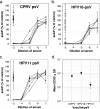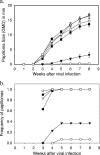Preclinical model to test human papillomavirus virus (HPV) capsid vaccines in vivo using infectious HPV/cottontail rabbit papillomavirus chimeric papillomavirus particles
- PMID: 17005666
- PMCID: PMC1676303
- DOI: 10.1128/JVI.01583-06
Preclinical model to test human papillomavirus virus (HPV) capsid vaccines in vivo using infectious HPV/cottontail rabbit papillomavirus chimeric papillomavirus particles
Abstract
A human papillomavirus (HPV) vaccine consisting of virus-like particles (VLPs) was recently approved for human use. It is generally assumed that VLP vaccines protect by inducing type-specific neutralizing antibodies. Preclinical animal models cannot be used to test for protection against HPV infections due to species restriction. We developed a model using chimeric HPV capsid/cottontail rabbit papillomavirus (CRPV) genome particles to permit the direct testing of HPV VLP vaccines in rabbits. Animals vaccinated with CRPV, HPV type 16 (HPV-16), or HPV-11 VLPs were challenged with both homologous (CRPV capsid) and chimeric (HPV-16 capsid) particles. Strong type-specific protection was observed, demonstrating the potential application of this approach.
Figures




Similar articles
-
Broad Cross-Protection Is Induced in Preclinical Models by a Human Papillomavirus Vaccine Composed of L1/L2 Chimeric Virus-Like Particles.J Virol. 2016 Jun 24;90(14):6314-25. doi: 10.1128/JVI.00449-16. Print 2016 Jul 15. J Virol. 2016. PMID: 27147749 Free PMC article.
-
Protection of rabbits against cutaneous papillomavirus infection using recombinant tobacco mosaic virus containing L2 capsid epitopes.Vaccine. 2006 Jun 29;24(26):5516-25. doi: 10.1016/j.vaccine.2006.04.058. Epub 2006 May 6. Vaccine. 2006. PMID: 16725236
-
The seroprevalence of IgG antibodies to human papillomavirus (HPV) types HPV-16, HPV-18, and HPV-11 capsid-antigens in mothers and their children.J Med Virol. 2007 Sep;79(9):1370-4. doi: 10.1002/jmv.20874. J Med Virol. 2007. PMID: 17607783
-
Chapter 12: Prophylactic HPV vaccines: underlying mechanisms.Vaccine. 2006 Aug 31;24 Suppl 3:S3/106-13. doi: 10.1016/j.vaccine.2006.05.110. Epub 2006 Jun 23. Vaccine. 2006. PMID: 16949996 Review.
-
Papillomavirus virus-like particles as vehicles for the delivery of epitopes or genes.Arch Virol. 2006 Nov;151(11):2133-48. doi: 10.1007/s00705-006-0798-8. Epub 2006 Jun 22. Arch Virol. 2006. PMID: 16791442 Review.
Cited by
-
Structural comparison of four different antibodies interacting with human papillomavirus 16 and mechanisms of neutralization.Virology. 2015 Sep;483:253-63. doi: 10.1016/j.virol.2015.04.016. Epub 2015 May 19. Virology. 2015. PMID: 25996608 Free PMC article.
-
High-Resolution Structure Analysis of Antibody V5 and U4 Conformational Epitopes on Human Papillomavirus 16.Viruses. 2017 Dec 6;9(12):374. doi: 10.3390/v9120374. Viruses. 2017. PMID: 29211035 Free PMC article.
-
A protective and broadly cross-neutralizing epitope of human papillomavirus L2.J Virol. 2007 Dec;81(24):13927-31. doi: 10.1128/JVI.00936-07. Epub 2007 Oct 10. J Virol. 2007. PMID: 17928339 Free PMC article.
-
Incorporation of RG1 epitope concatemers into a self-adjuvanting Flagellin-L2 vaccine broaden durable protection against cutaneous challenge with diverse human papillomavirus genotypes.Vaccine. 2017 Sep 5;35(37):4942-4951. doi: 10.1016/j.vaccine.2017.07.086. Epub 2017 Aug 1. Vaccine. 2017. PMID: 28778613 Free PMC article.
-
Immunogenicity of bivalent human papillomavirus DNA vaccine using human endogenous retrovirus envelope-coated baculoviral vectors in mice and pigs.PLoS One. 2012;7(11):e50296. doi: 10.1371/journal.pone.0050296. Epub 2012 Nov 27. PLoS One. 2012. PMID: 23209698 Free PMC article.
References
-
- Breitburd, F., R. Kirnbauer, N. L. Hubbert, B. Nonnenmacher, C. Trin-Dinh-Desmarquet, G. Orth, J. T. Schiller, and D. R. Lowy. 1995. Immunization with virus-like particles from cottontail rabbit papillomavirus (CRPV) can protect against experimental CRPV infection. J. Virol. 69:3959-3963. - PMC - PubMed
-
- Harper, D. M., E. L. Franco, C. Wheeler, D. G. Ferris, D. Jenkins, A. Schuind, T. Zahaf, B. Innis, P. Naud, N. S. De Carvalho, C. M. Roteli-Martins, J. Teixeira, M. M. Blatter, A. P. Korn, W. Quint, and G. Dubin. 2004. Efficacy of a bivalent L1 virus-like particle vaccine in prevention of infection with human papillomavirus types 16 and 18 in young women: a randomised controlled trial. Lancet 364:1757-1765. - PubMed
Publication types
MeSH terms
Substances
LinkOut - more resources
Full Text Sources
Other Literature Sources

